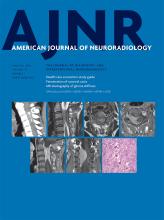Index by author
Verma, G.
- EDITOR'S CHOICEHead and Neck ImagingOpen AccessDynamic Contrast-Enhanced MRI–Derived Intracellular Water Lifetime (τi): A Prognostic Marker for Patients with Head and Neck Squamous Cell CarcinomasS. Chawla, L.A. Loevner, S.G. Kim, W.-T. Hwang, S. Wang, G. Verma, S. Mohan, V. LiVolsi, H. Quon and H. PoptaniAmerican Journal of Neuroradiology January 2018, 39 (1) 138-144; DOI: https://doi.org/10.3174/ajnr.A5440
The authors evaluated 60 patients with dynamic contrast-enhanced MR imaging before treatment. Median, mean intracellular water molecule lifetime, and volume transfer constant values from metastatic nodes were computed from each patient. Kaplan-Meier analyses were performed to associate mean intracellular water molecule lifetime and volume transfer constant and their combination with overall survival and beyond. Patients with high mean intracellular water molecule lifetime had overall survival significantly prolonged by 5 years compared with those with low mean intracellular water molecule lifetime. Patients with high mean intracellular water molecule lifetime had significantly longer overall survival at long-term duration than those with low mean intracellular water molecule lifetime. Volume transfer constant was a significant predictor for only the 5-year follow-up period. They conclude that a combined analysis of mean intracellular water molecule lifetime and volume transfer constant provided the best model to predict overall survival in patients with squamous cell carcinomas of the head and neck.
Vitorino, R.
- Adult BrainOpen AccessSpatial Correlation of Pathology and Perfusion Changes within the Cortex and White Matter in Multiple SclerosisA.D. Mulholland, R. Vitorino, S.-P. Hojjat, A.Y. Ma, L. Zhang, L. Lee, T.J. Carroll, C.G. Cantrell, C.R. Figley and R.I. AvivAmerican Journal of Neuroradiology January 2018, 39 (1) 91-96; DOI: https://doi.org/10.3174/ajnr.A5410
Vrenken, H.
- EDITOR'S CHOICEAdult BrainOpen AccessReproducibility of Deep Gray Matter Atrophy Rate Measurement in a Large Multicenter DatasetA. Meijerman, H. Amiri, M.D. Steenwijk, M.A. Jonker, R.A. van Schijndel, K.S. Cover and H. Vrenken for the Alzheimer's Disease Neuroimaging InitiativeAmerican Journal of Neuroradiology January 2018, 39 (1) 46-53; DOI: https://doi.org/10.3174/ajnr.A5459
The authors assessedthereproducibilityof2automatedsegmentationsoftwarepackages(FreeSurferandthe FMRIB Integrated Registration and Segmentation Tool) by quantifying the volume changes of deep GM structures by using back-to-back MR imaging scans from the Alzheimer Disease Neuroimaging Initiative's multicenter dataset in 562 subjects. Back-to-back differences in 1-year percentage volume change were approximately 1.5–3.5 times larger than the mean measured 1-year volume change of those structures. They conclude that longitudinal deep GM atrophy measures should be interpreted with caution and that deep GM atrophy measurement techniques require substantially improved reproducibility, specifically when aiming for personalized medicine.








